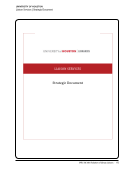SPEC Kit 349: Evolution of Library Liaisons · 19
increasingly important for liaisons to participate in
these conversations and articulate their goals and
ideas for measuring progress or success. In 1992, SPEC
Kit 189 called for library liaisons to “explore non-tra-
ditional and expanded roles” and to act as “contrib-
uting members of research teams and instructional
programs.”7It feels safe to write that this is exactly the
direction in which the library liaison role has evolved,
and that liaisons are now partnering in ways that were
unimaginable twenty-three years ago. At this point
in time, library liaisons have the opportunity and re-
sources to move beyond a “contributing” role in these
partnerships. Data from the current survey provide
strong evidence that liaisons are proactively leading
community conversations and initiatives in the ar-
eas of data management, teaching and learning, and
scholarly communication. We will continue to see the
liaison role shift and evolve, as library liaisons move
from contributing partners to full-fledged leaders in
the education and research enterprise.
Endnotes
1. Kenney, Anne R. Leveraging the Liaison Model:
From Defining 21st Century Research Libraries to
Implementing 21st Century Research Universities.
Ithaka S+R, New York: Ithaka S+R, March 2014.
2. Latta, Gail F. Liaison Services in ARL Libraries.
SPEC Kit 189. Washington, DC: Association of
Research Libraries, November/December 1992.
3. Ibid.
4. Logue, Susan, John Ballestro, Andrea Imre,
and Julie Arendt. Liaison Services. SPEC
Kit 301, Washington, DC: Association
of Research Libraries, October 2007.
5. Ibid.
6. Reference and User Services Association.
“Guidelines for Liaison Work in Managing
Collections and Services.” Accessed
October 29, 2015. http://www.ala.org/rusa/
resources/guidelines/guidelinesliaison
7. Latta, Liaison Services in ARL Libraries.
increasingly important for liaisons to participate in
these conversations and articulate their goals and
ideas for measuring progress or success. In 1992, SPEC
Kit 189 called for library liaisons to “explore non-tra-
ditional and expanded roles” and to act as “contrib-
uting members of research teams and instructional
programs.”7It feels safe to write that this is exactly the
direction in which the library liaison role has evolved,
and that liaisons are now partnering in ways that were
unimaginable twenty-three years ago. At this point
in time, library liaisons have the opportunity and re-
sources to move beyond a “contributing” role in these
partnerships. Data from the current survey provide
strong evidence that liaisons are proactively leading
community conversations and initiatives in the ar-
eas of data management, teaching and learning, and
scholarly communication. We will continue to see the
liaison role shift and evolve, as library liaisons move
from contributing partners to full-fledged leaders in
the education and research enterprise.
Endnotes
1. Kenney, Anne R. Leveraging the Liaison Model:
From Defining 21st Century Research Libraries to
Implementing 21st Century Research Universities.
Ithaka S+R, New York: Ithaka S+R, March 2014.
2. Latta, Gail F. Liaison Services in ARL Libraries.
SPEC Kit 189. Washington, DC: Association of
Research Libraries, November/December 1992.
3. Ibid.
4. Logue, Susan, John Ballestro, Andrea Imre,
and Julie Arendt. Liaison Services. SPEC
Kit 301, Washington, DC: Association
of Research Libraries, October 2007.
5. Ibid.
6. Reference and User Services Association.
“Guidelines for Liaison Work in Managing
Collections and Services.” Accessed
October 29, 2015. http://www.ala.org/rusa/
resources/guidelines/guidelinesliaison
7. Latta, Liaison Services in ARL Libraries.












































































































































































































